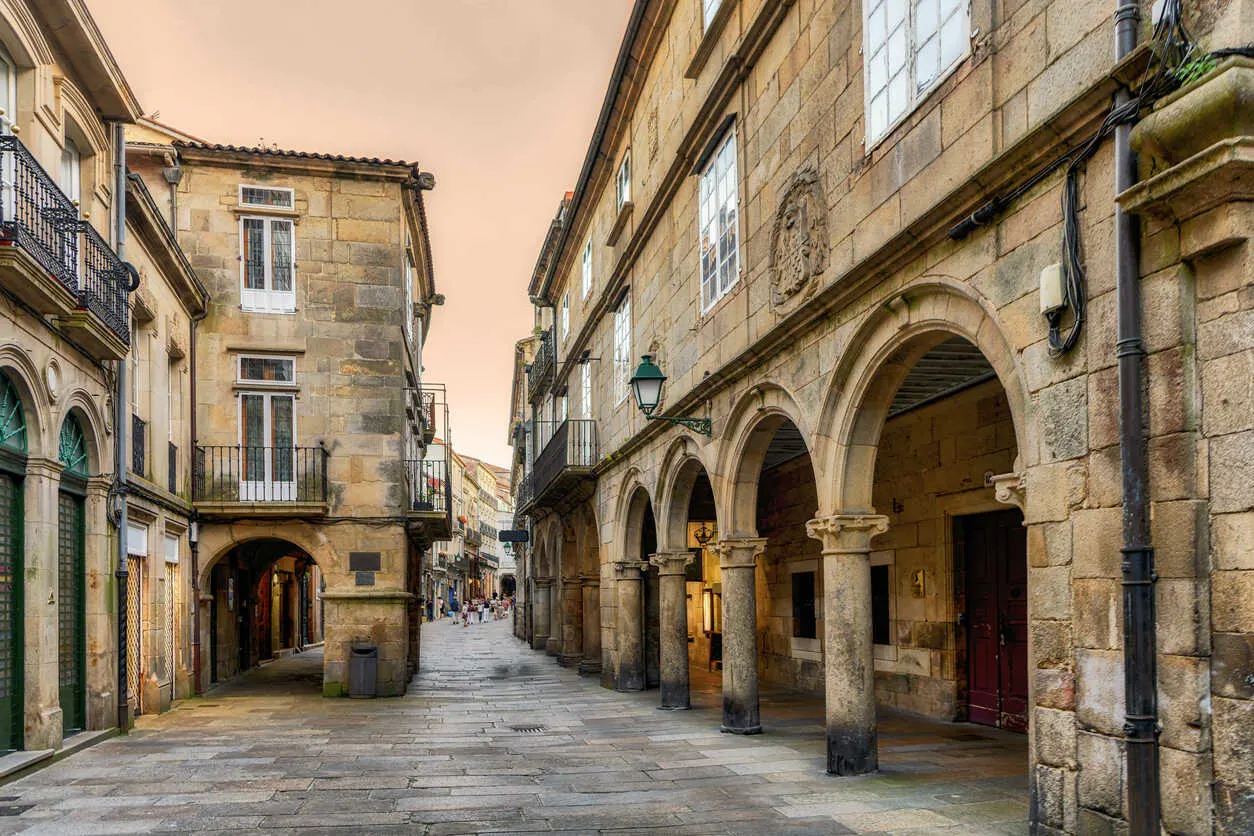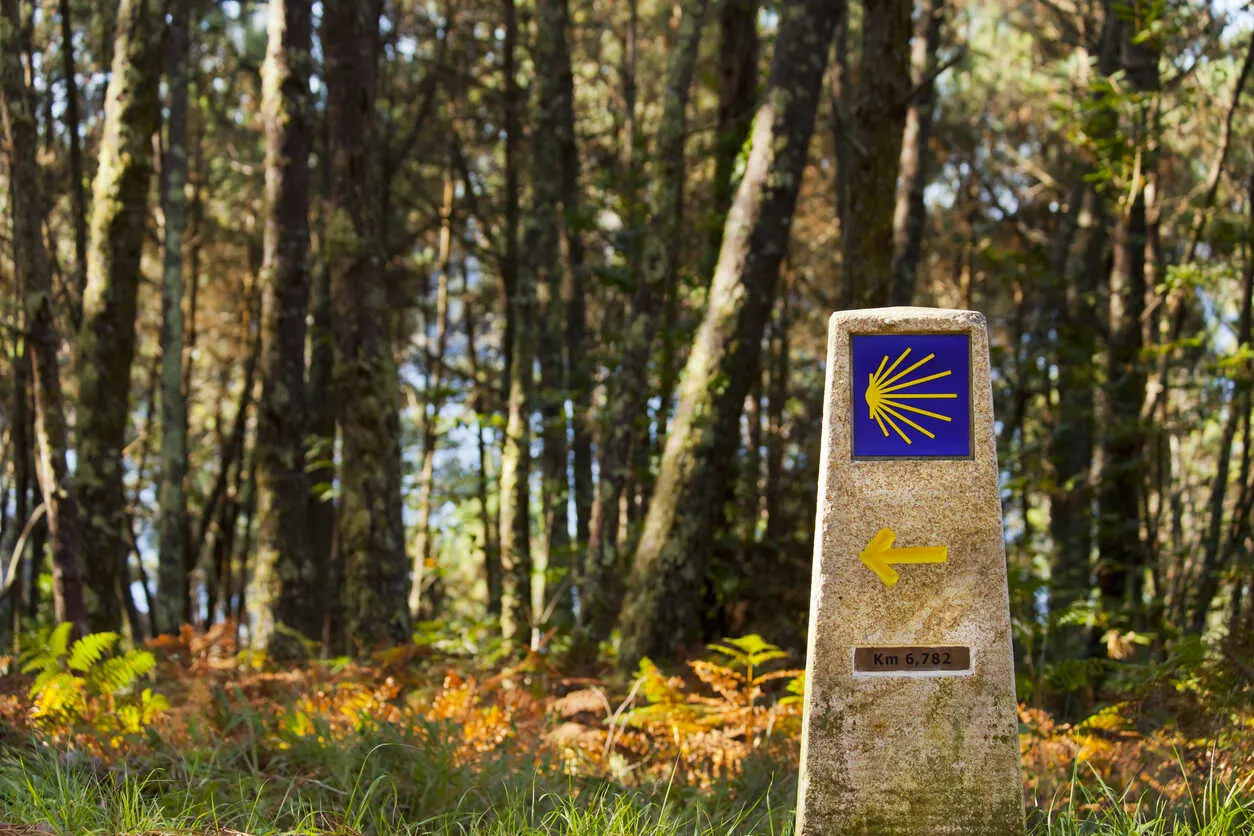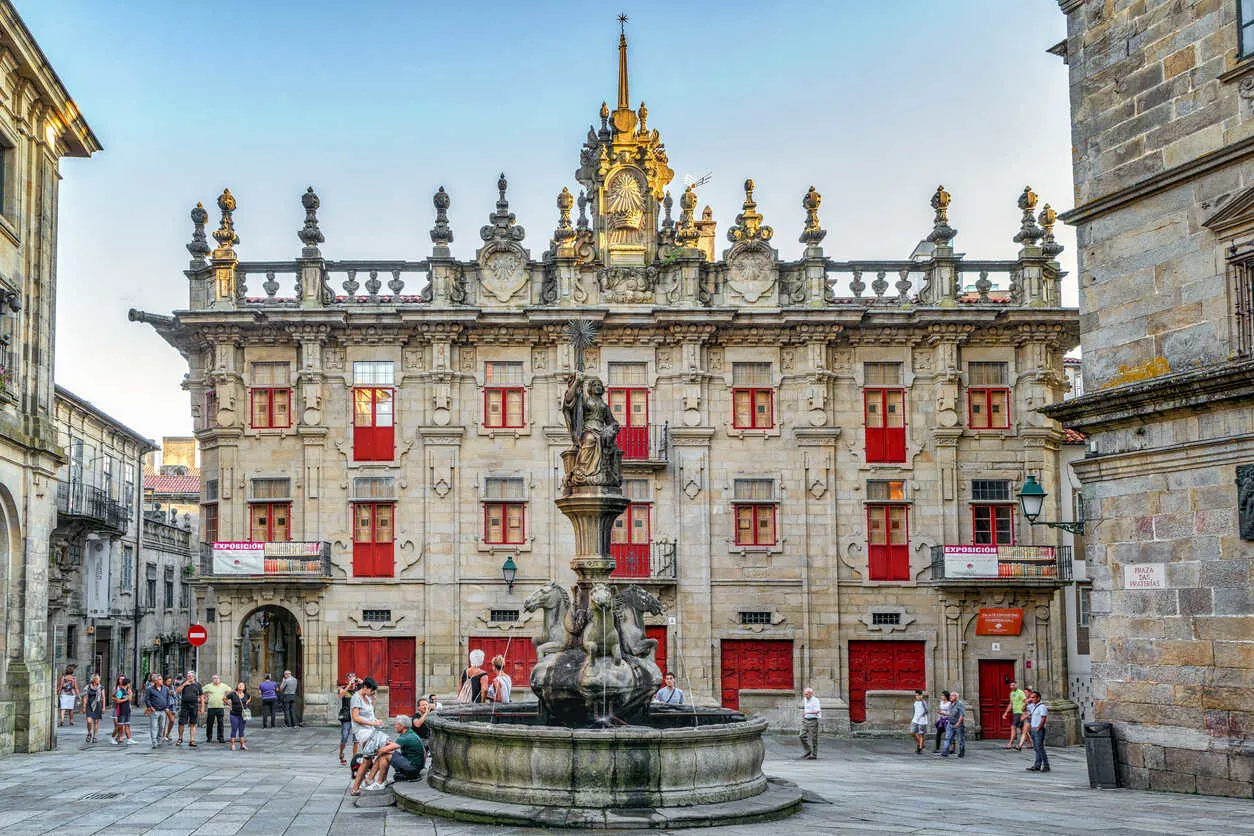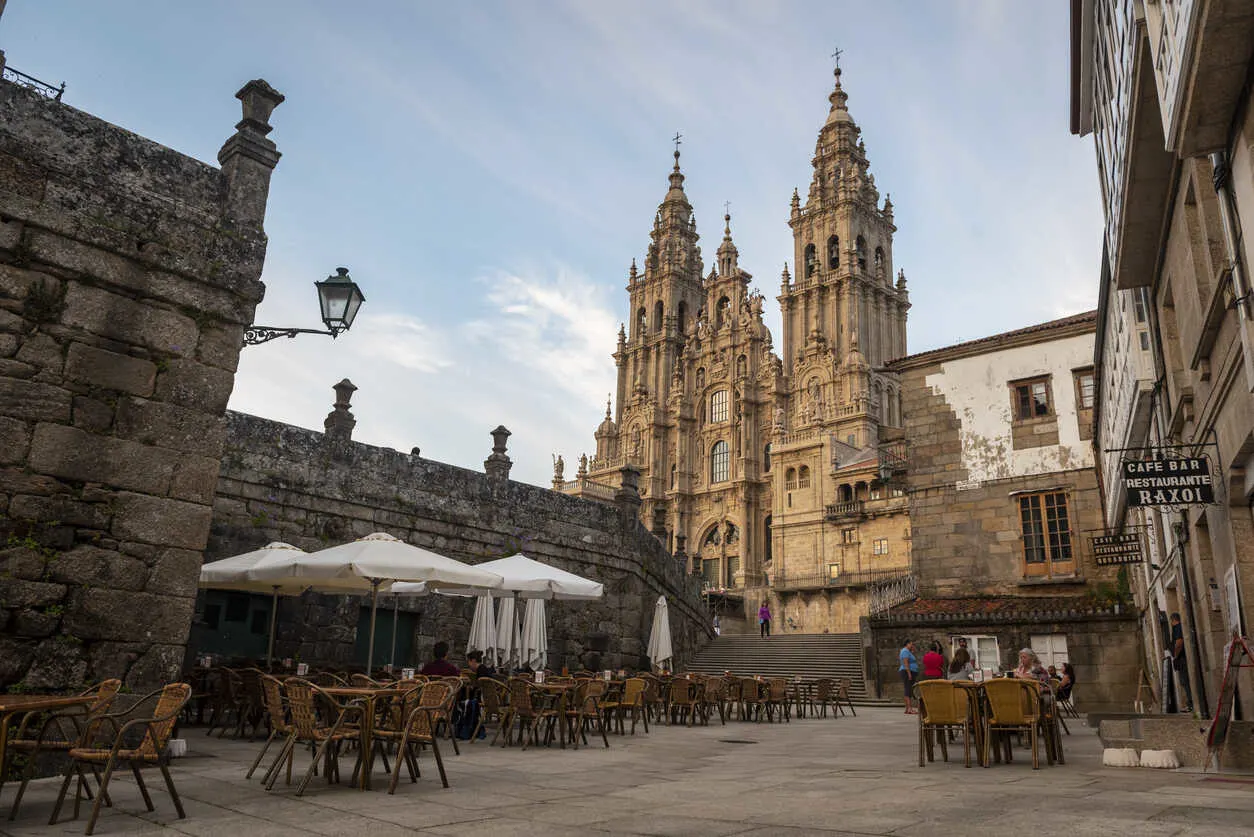As I stood in the middle of the rugged carpet of cobblestones, staring at the colossal cathedral in front of me, I was filled with a sense of peace that wrapped around me like a fluffy blanket. The elaborately carved facades and towers of the medieval structure seemed to reach up to the heavens and give off an unearthly glow. Its presence made me feel tiny—like a speck of dust in the universe, arriving here to understand a bit more about this magical, spiritual destination.
I was surrounded by hundreds of pilgrims of all ages, sizes, and ethnicities who had landed here at the finishing line of the famous Camino de Santiago, or The Way of Saint James. The Camino routes are scattered throughout Europe and consist of varying distances, but all end here in the cathedral square.
Some groups of pilgrims were singing; others proudly waved flags of their countries, and many were lying on the ground, resting from their arduous journey. One couple in particular caught my eye and left a lasting impression.
They were a couple in their fifties, wearing khaki shorts, tees, hats, hiking boots, and backpacks, carrying walking sticks. The man looked out into the massive crowd of pilgrims with a grin from ear to ear, eyes wide open, and a look of relief that said, “Honey, we did it.” The woman, her auburn curly hair pulled back into a ponytail, glanced over at him with tears of joy running down her face. It was apparent by their expressions that they had just accomplished something enormously special, something that would leave an imprint on their souls forever.
Get Your Free Spain Report Today!
Get Your Free Spain Report Today!
Learn more about the lower cost of living in Spain and other countries in our free daily postcard e-letter. Simply enter your email address below and we'll also send you a FREE REPORT — Live the Good Life in Sunny, Affordable Spain.

By submitting your email address, you will receive a free subscription to IL Postcards, The Untourist Daily and special offers from International Living and our affiliates. You can unsubscribe at any time, and we encourage you to read more about our Privacy Policy.
Santiago’s History and Spiritual Significance

Santiago de Compostela, the capital of northwest Spain’s Galicia region, has been an important Catholic pilgrimage site since the 9th century and is reputed to be the burial site of the apostle Saint James. “Santiago” means James in Spanish, while “Compostela” translates to "field of stars," similar to the Milky Way.
According to legend passed down from the Middle Ages, James the Apostle instructed pilgrims to follow the stars, and they would find him—and they have, for many centuries. Each year, over 400,000 pilgrims commit to this walk for many different reasons. In 1985, UNESCO declared the Old Town of the city a World Heritage Site.
Walking the Camino: Stories from the Trail

Being a curious person, I wanted to know why people put their lives on hold for weeks or months at a time to walk the Camino. Why would someone want to walk every day, all day, while carrying heavy packs on their backs? So, I asked a few of our friends who had taken the plunge and lived to share their experiences.
For Julie Morris, this was her second time around. “The Camino is different for everyone. For some, it’s spiritual; for others, it’s about setting personal goals or just enjoying the breathtaking scenery and meeting interesting people along the way. I never thought I’d be fit enough to tackle 16 miles a day, but it’s actually not as hard as it seems. Unlike true pilgrims, we hired a company to transport our luggage from one stop to the next, so we only carried day packs with snacks and water. We stopped for lunches along the way or to rest and admire the views. It provided food for my soul and made me appreciate my life more.”
For Bina and Ken Cline, “after being married for 30 years, walking the Camino helped bring us closer together. It provided us with a welcome opportunity to spend time with each other without the usual background noise. We overcame challenges along the way as a team—not me, not her, but us together. As we stood in front of the cathedral, we embraced long and hard. Bina sobbed into my shoulder, and I became a bit choked up, too. We held hands as we looked at the impressive building and thanked God for guiding our steps along the Camino. It was a major accomplishment we tackled together,” Ken added.
Living Affordably in Santiago: What It Really Costs

The city of Santiago de Compostela has a population of about 95,000 and is situated just 358 miles from the border it shares with Portugal. The official languages spoken are Spanish and Galician, a Romance language similar to Portuguese. English is also fairly common in the Old Town, with the obvious influx of pilgrims from around the world.
The University of Santiago, one of the oldest universities still in continuous operation, has a student body of 42,000, giving the city a youthful vibe. The university offers some of the lowest tuition costs in Spain, though most courses are only available in Spanish.
Year-round weather in Santiago de Compostela includes warm, mostly dry summers and cold, cloudy, and very rainy winters. Average temperatures range from 40 F to 76 F, with highs rarely exceeding 87 F, and lows rarely dipping below freezing.
Learning Spanish is advisable for anyone wishing to relocate to Santiago de Compostela, as English speakers are far less common outside of the Old Town. Our knowledge of Latin American Spanish managed to get us by. All signs and menus are posted in both Spanish and what seemed to be Portuguese, but it could have been Galician.
Outside of Old Town, the city has changed to a more tranquil Spanish city with high-rise apartment complexes. Corner cafes are filled with beret-wearing elderly gentlemen sipping coffee and watching the world go by.
The city’s terrain is quite hilly, with many cobblestone roads that may be difficult for some to navigate. Public transport includes city buses, taxis, and bike rentals.
Housing is affordable, thanks to the student population. A one-bedroom furnished apartment can be rented long-term for $600 a month, while larger two- or three-bedroom furnished apartments can be found for $900 a month. Add another $135 for utilities (electricity, water, and gas), $50 for a phone/internet package, $350 for food/groceries, and $150 for dining out and entertainment. A monthly bus pass can be purchased for $33.
New residents will need to purchase private health insurance. Sanitas, Spain’s largest health insurance company, quoted a basic plan for a healthy 64-year-old couple at $326 a month, with a more comprehensive plan at $533. After living in Spain for one to five years, depending on the region, residents can access low-cost public healthcare through the “convenio especial.” Costs range from $67 a month for those under 65 to $175 for those over 65.
A couple without a car could live in this historic city for as little as $1,644 a month with basic health insurance and a small apartment or up to $2,387 a month with a larger furnished apartment and top-tier health insurance.
Get Your Free Spain Report Today!
Get Your Free Spain Report Today!
Learn more about the lower cost of living in Spain and other countries in our free daily postcard e-letter. Simply enter your email address below and we'll also send you a FREE REPORT — Live the Good Life in Sunny, Affordable Spain.

By submitting your email address, you will receive a free subscription to IL Postcards, The Untourist Daily and special offers from International Living and our affiliates. You can unsubscribe at any time, and we encourage you to read more about our Privacy Policy.
Living Like a Local: Tips for Expats in Santiago
There are several Facebook groups, like “Expats in Santiago de Compostela,” that help expats connect. InterNations, a worldwide organization, can also be a great resource for finding information and meeting others.
Taking Spanish classes—whether private or in groups—is a great way to meet people and make new friends. Americans often seek out other Americans, but building friendships with people from different countries can be both rewarding and educational.
Knowing Spanish will make everyday life in Spain easier and show respect to locals. For those needing a Spanish driver’s license, any "autoescola" can provide more details.
Must-See Attractions in Santiago: Exploring History and Culture

The Old Town is compact, with the Cathedral of Santiago de Compostela taking center stage. Construction of the Romanesque church began in 1075 and was completed in 1211. Built with three naves and a Latin cross floor plan, the cathedral covers 90,000 square feet. Pilgrims wait in long lines to hug the statue of Saint James and visit his tomb, both free to access. Tickets can be purchased to visit the cathedral’s terraces and tower. The 45-minute tour, offered only in Spanish, takes visitors 246 feet up to the pinnacle of the roof. This may not be suitable for elderly visitors, families with small children, or those with a fear of heights.
Opposite the cathedral is Raxoi Palace, constructed in 1766 and originally used as a seminary for confessors. Today, it houses City Hall and other government offices. Its magnificent Neoclassical façade, built on a granite colonnade with fourteen half-moon arches, offers a perfect shady spot to admire the cathedral.
The Museum of Galician Culture, located in the old convent of Santo Domingo de Bonaval, offers insight into the Galician people through displays of their trades, seafaring history, clothing, music, and more. Nearby, the Galician Contemporary Art Museum showcases local artists in a striking modern structure, with terraces that provide views over the Old Town.
Believers from around the world come to Santiago de Compostela for various reasons—some after a long, strenuous hike, seeking to fulfill a lifelong dream, or expecting a miracle. Tourists visit to admire its architectural wonders and learn about its legends and lore.
Students and expats arrive with their visas in hand, ready to start a new chapter in this charming city.
Get Your Free Spain Report Today!
Get Your Free Spain Report Today!
Learn more about the lower cost of living in Spain and other countries in our free daily postcard e-letter. Simply enter your email address below and we'll also send you a FREE REPORT — Live the Good Life in Sunny, Affordable Spain.

By submitting your email address, you will receive a free subscription to IL Postcards, The Untourist Daily and special offers from International Living and our affiliates. You can unsubscribe at any time, and we encourage you to read more about our Privacy Policy.
